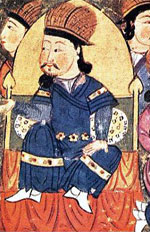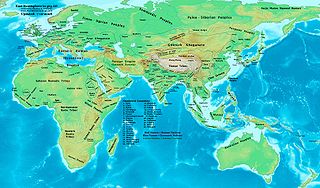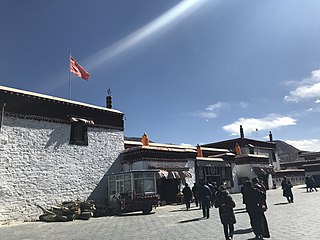
Tibetan history, as it has been recorded, is particularly focused on the history of Buddhism in Tibet. This is partly due to the pivotal role this religion has played in the development of Tibetan and Mongol cultures and partly because almost all native historians of the country were Buddhist monks.

Altan Khan of the Tümed, whose given name was Anda, was the leader of the Tümed Mongols, Shunyi Wang of Ming dynasty China, and de facto ruler of the Right Wing, or western tribes, of the Mongols. He was the grandson of Dayan Khan (1464–1543), a descendant of Kublai Khan (1215–1294), who had managed to unite a tribal league between the Khalkha Mongols in the north and the Chahars (Tsakhars) to the south. His name means "Golden Khan" in the Mongolian language.

Guge was an ancient kingdom in Western Tibet. The kingdom was centered in present-day Zanda County, Ngari Prefecture, Tibet Autonomous Region. At various points in history after the 10th century AD, the kingdom held sway over a vast area including south-eastern Zanskar, Upper Kinnaur district, and Spiti Valley, either by conquest or as tributaries. The ruins of the former capital of the Guge kingdom are located at Tsaparang in the Sutlej valley, not far from Mount Kailash and 1,200 miles (1,900 km) westwards from Lhasa.

Songtsen Gampo, also Songzan Ganbu(Chinese: 松贊干布 Sōngzàn Gānbù), was the 33rd Tibetan king and founder of the Tibetan Empire, and is traditionally credited with the introduction of Buddhism to Tibet, influenced by his Nepali and Chinese queens, as well as being the unifier of what were previously several Tibetan kingdoms. He is also regarded as responsible for the creation of the Tibetan alphabet and therefore the establishment of Classical Tibetan, the language spoken in his region at the time, as the literary language of Tibet.

Tuyuhun was a powerful kingdom established by nomadic peoples related to the Xianbei in the Qilian Mountains and upper Yellow River valley.
Tibet is a landlocked region in Asia.

Lha Thothori gNyan bTsan was the 28th King of Tibet according to the Tibetan legendary tradition. Lha "divine, pertaining to the gods of the sky" is an honorary title and not a part of his proper name.

Tradruk Temple in the Yarlung Valley is the earliest great geomantic temple after the Jokhang and some sources say it predates that temple.

The following outline is provided as an overview of and topical guide to Tibet:
Namri Songtsen, also known as "Namri Löntsen" (570?–618?/629) was, according to tradition, the 32nd King of Tibet of the Yarlung Dynasty, which until his reign ruled only the Yarlung Valley. He expanded his kingdom to rule the central part of the Tibetan Plateau. His actions were decisive in the setting up of the Tibetan Empire, to which he can be named co-founder with his son, Songtsen Gampo.

Tibet under Yuan rule refers to the Yuan dynasty's rule over Tibet from approximately 1270 to 1354. During the Yuan rule of Tibet, the region was structurally, militarily and administratively controlled by the Mongol Yuan dynasty, a division of the Mongol Empire. In the history of Tibet, The Mongol rule was established after Sakya Pandita got power in Tibet from the Mongols in 1244, following the 1240 Mongol conquest of Tibet led by the Mongol general with the title doord darkhan. It is also called the Sakya dynasty after the favored Sakya school of Tibetan Buddhism.

The Era of Fragmentation is a period of Tibetan history in the 9th and 10th century. During this era, the political centralization of the earlier Tibetan Empire collapsed following a civil war between Yumtän and Ösung (’Od-srung). The period was dominated by rebellions against the remnants of imperial Tibet and the rise of regional warlords.
Buddhism was first actively disseminated in Tibet from the 7th to the 9th century CE, predominantly from India. During the Era of Fragmentation, Buddhism waned in Tibet, only to rise again in the 11th century. With the Mongol invasion of Tibet in the 13th century and the establishment of the Mongol Yuan dynasty, Tibetan Buddhism spread beyond Tibet to Mongolia and China. From the 14th to the 20th Tibetan Buddhism was patronized by the Chinese Ming dynasty (1368–1644) and the Manchurian Qing dynasty (1644–1912).

Polhané Sönam Topgyé was one of the most important political personalities of Tibet in the first half of the 18th century. Between 1728 and 1747 he was effectively the ruling prince of Tibet and carried royal titles during the period of Qing rule of Tibet. He is known as an excellent administrator, a fearsome warrior and a grand strategist. After the troubled years under the reign of Lhazang Khan, the bloody invasion of Tsering Dhondup and the civil war, his government ushered in a relatively long period of stability and internal and external peace for Tibet.
Tenzin Wangchuk Khan was the fourth khan of the Khoshut Khanate and protector-king of Tibet. He reigned from 1696 to 1697, or from 1701 to 1703, during the age of the 6th Dalai Lama, Tsangyang Gyatso.

The Bureau of Buddhist and Tibetan Affairs, or Xuanzheng Yuan was a government agency and top-level administrative department set up in Khanbaliq that supervised Buddhist monks in addition to managing the territory of Tibet during the Yuan dynasty (1271-1368) established by Kublai Khan. It was originally set up in 1264 as an autonomous office named Zongzhi Yuan or the Bureau of General Regulation, before it was renamed in 1288, which was named after the Xuanzheng Hall where Tibetan envoys were received in the Tang dynasty. In the Mongol Empire, Tibet was managed by the Bureau of Buddhist and Tibetan Affairs, separate from the other provinces of the Yuan dynasty such as those governed the former Song dynasty of China, but still under the administrative rule of the Yuan. While no modern equivalents remain, the political functions of the Bureau of Buddhist and Tibetan Affairs might have been analogous to the India Office in London during the British Raj. Besides holding the title of Imperial Preceptor or Dishi, Drogön Chögyal Phagpa, the fifth leader of the Sakya school of Tibetan Buddhism, was concurrently named the director of the Bureau of Buddhist and Tibetan Affairs. One of the department's purposes was to select a dpon-chen, usually appointed by the lama and confirmed by the Mongol emperor in Beijing. Tibetan Buddhism was not only practiced within the capital Beijing but throughout the country. Apart from Tibetan affairs, the Bureau of Buddhist and Tibetan Affairs managed the entire Buddhist clergy throughout the realm, and supervised all temples, monasteries, and other Buddhist properties in the empire, at least in name. According to scholar Evelyn Rawski, it supervised 360 Buddhist monasteries. To emphasize its importance for Hangzhou, capital of the former Southern Song dynasty and the largest city in the Yuan realm, a branch Xuanzheng Yuan was established in that city in 1291, although Tibetan Buddhism took public or official precedence over Han Chinese Buddhism.












